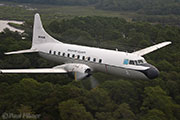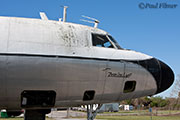In a sleepy corner of South Carolina is a unique spray operation that never ventures out of their immediate area. Beaufort County Airport is where the Beaufort County Mosquito Control (BCMC) aviation arm is based with their 1950s aircraft. The airport is also known as Lady’s Island and also to the locals as Frogmore International Airport, a name that is derived from the proximity of the Frogmore Plantation and Frogmore Manor that Queen Victoria used as a retreat.
Along with a single Hughes 500D helicopter they operate a pair of C-131Fs (Convair 340) fitted with spray booms to combat the relentless mosquito population in this low lying coastal community.
The mosquito season is generally from April to November with early morning sorties being the norm as they must stop application if the temperature rises above 82°F (27.7°C) as this when the mosquitoes become inactive. Early morning is also preferred as honey bees are still inactive in their hives, and are therefore not placed at risk. There is an incredible 57 species of mosquitoes listed as active in the area.
The Field Supervisor and the Deputy Director evaluate all the gathered information available from the county and they then develop a spay mission map for the pilots. That will be handed to either the chief pilot or the engineer in the afternoon so the mission can be flown at daybreak the following day.
The crew scope out the area using a map and when the spraying starts switch over to special Ag Nav Guia GPS system that is fitted to each aircraft. The units have the capability to document the spray patterns advising the crew where they have sprayed and where to spray next, taking into account wind and drift.
Spraying is usually done at around 200 feet and at 170 knots and unlike most aerial applications an ultra-low volume spray or thermal fogging technique is used - the actual volume of insecticide is only around 1-1.5 ounces per acre.
Aqua Anvil is the insecticide of choice and it is diluted with water at a 1:1 ratio. The very small droplets produce a fog which drifts into sites where adult mosquitoes are flying, biting, or resting. The insecticide interferes with the mosquito nervous system and causes paralysis and eventual death.
The aircraft themselves are fitted with a single 600 gallon tank and at 170 knots with their large wingspan they can cover an astonishing 606 acres per minute and 3600 acres per mission.
The aircraft are operated on the public use category and are limited to 38,900 lbs take-off weight due to the 34000 foot runway they operate from. They are generally never near that weight however.
They are only allowed to spray within the county (600 square miles) as the aircraft are public use. An exception would be an emergency where the Federal Emergency Management Agency (FEMA) could call upon them to operate anywhere within the USA. Beaufort County has over 2,000 islands with many that are prime breeding grounds for mosquitoes, but any spaying over salt water marshes is prohibited due to environmental concerns.
Beaufort County stated utilising aerial application for mosquito control in the 70s and up until the 80s the work was contracted out to a separate DC-3 operator. The county acquired two TH-55 Osage (Hughes 269) helicopters in 1987 thereby taking over the operation internally.
In June 1987 a C-117 (DC-3S) was donated to the county from the Drug Enforcement Administration (DEA) and was operated for 12 years but numerous engine failures and the ever dwindling spare parts available were hindering the operations so they began discussing the replacement of the DC-3S. This particular C-117 (N53315) now flies for TransNorthern in Alaska as N30TN and was sold in 2004.
Tom Ray, the counties airports director contacted both the Air Force and the Navy Surplus offices. The Air Force offered to donate upwards of four C-123 Provider aircraft and the Navy offered up for donation all 16 of the C-131F Samaritan planes they had in storage at Davis-Monthan AFB. Because of the runway length at Lady's Island airport plus the limited parts supply for the C-123 they opted for the C-131s.
Beaufort County opted for three of the C-131Fs and these were donated by the US Navy to the state of South Carolina and were then in turn sold to Beaufort County for $1000 a piece. The county had an obligation to use the aircraft for 5 years after which the state releases full control to the county who then own them outright.
In April of 1998, the first of the three C-131s arrived in Beaufort, SC. This was the Admirals ex plane, Bureau number 141018, N444F. A contract crew flew the aircraft first from Tucson International to Dothan, Alabama Napier Field, with the flight to Lady's Island Airport the following day. When the contract pilot first sighted the runway at Lady's Island he later admitted that he had grave concern about landing on such a short runway and almost deviated to Walteboro to the north - co-incidentally Walterboro, Lowcountry Regional Airport is where they perform most of the crew training at the beginning of each season.
This aircraft was used for training and obtaining type ratings and this enabled two flight crews to travel to Tucson in November 1998 to pick up the two remaining Convairs.
Bu141008, N8149H and Bu141009, N8149P were both flown non-stop to Beaufort, 1890 nautical miles at a flight time of 7 hours 10 minutes. In the following months N81940P was the first to be converted into an aerial sprayer.
The summer of 1999 was N8149Ps first spray season we it flew for 71 hours and sprayed 498,000 acres.
In 2000 N8149H was flown to Souther Field in Americus, Georgia, and the Airframe and Powerplant (A&P) students at the South West Technical College installed the beef plates on the underside of the wings at no charge to the county.
By the summer of 2001 both aircraft were up and performing aerial spray missions. Since the beginning of aerial spray missions in June 1999 over four million acres have been sprayed without a single mishap and both sprayers have performed flawlessly. Not one single spray mission has ever been cancelled due to maintenance which is both a testament to the old aircraft and the maintenance crew led by Gary Davy at Lady’s Island.
The only problem that had to be overcome with operating the Convairs at Lady’s Island is the runway length. At 3430 feet this limits the take off weight to 36,900 pounds. The airplane at this weight is more than capable of flying from this runway with an engine failure on take off.
Truman Davis, chief pilot, takes up the story. "We had one instance where the door warning light came on during our take off roll. We were almost past our V1 speed of 92 KIA when the abort was called and the airplane came to a full stop with over 300 feel of runway remaining. The small cargo door on the right side of the plane had not been closed properly which gave us the unsafe door warning."
"As for flying the Convairs, they are a delight to fly. They are very stable, reliable, safe and overall an excellent airplane, and don’t have any bad flight characteristics in all configurations and airspeeds. The Pratt and Whitney R2800 CB16 engines were one of the best radials ever produced. One point to note, Eastern and Delta both operated the Convair 340 and 440 for many years and when they retired them in the 1970s, neither carrier had one single loss of a plane or life while operating them in all kinds of weather conditions. That in itself is testament of the safe and reliable planes they were and are."
Truman continues, "Beaufort County was the first and the only operator to use the Convair for aerial spraying so we really did not know the capabilities or exactly what to expect after we installed the "designed and built in house" spray system. After thoroughly testing them, we were amazed at how good a spray platform they turned out to be."
"We fly them at 170 KIA, at 200 feel AGL and this gives us an operating swath width of 1500 feet. The actual swatch width is well over 2,000 feet. We cover 606 acres per minute and a normal mission treats around 25,000 to 30,000 acres. Fuel consumption averages 130 gallons an hour total."
"On a personal note, I have flown several different heavy multi engine aircraft that have round or radial engines, including the B-25, B-17, Martin 404, PV2, DC-3 (C-47) and DC-3S or Super 3 - all of these airplanes have their own characteristics and qualities and faults, but the Convair I would rate number one to fly and maintain. It truly was a quantum leap ahead of the DC-3 that it was designed to replace."
Although the Conviars have been relatively inexpensive to operate this is potentially the last season for the old birds as the county is looking to replace them with three ex military C-12 King Air’s. One reason is that spare parts are becoming harder to find and more expensive, but the biggest hurdle is finding rated aircrew to fly them. The insurance requires 500 hours agricultural twin time which is an increasingly hard quality to find.
Typically a budget is formulated for each fiscal year using historical data for a "standard" year. Unfortunately every year is different due to weather etc, so some years there is money let over that can be used for spray equipment etc, and other years, when the mosquito population is heavy, money will run out and BCMC has to go back to the county council to beg for more money.
A further complication is that two mosquito seasons actually fall into the same fiscal year. The accountant’s fiscal year is from 1st July to 30th June of the next year, so the first mosquito season falls between 1 July to November then the second season starts and falls within the April though 30 June part of the fiscal year - this proves to be a huge task for the BCMC.
Mosquito control is responsive and not proactive and comes down to environmental conditions. High tides, rainfall and temperatures all become a factor in the type of response needed, and this is impossible to plan for ahead of time.
Beaufort County’s current mosquito control budget is $1.8M and has one of the lowest salary to operational budgets ratio (51%). Of this budget air operations surprisingly only takes up 37%, with the rest taken up with research, surveillance and ground operations.
Aircraft Histories:
C-131F 141008 - N8149H
1974 - NAS Sigonella
1976 - Guantanamo Bay
1981 - Bermuda
1986 - MASDC
1998 - Beaufort County - current
C-131F 141009 - N8149P
1967 - NAS Norfolk
1971 - NAF Mildenhall
1981 - Guantanamo Bay
1986 - MASDC
1998 - Beaufort County - current
C-131F 141018 – N4444F
various assignments in the USA
1986 - MASDC
1998 - Beaufort County to be used for spares.
Note: N4444F was never converted to a sprayer and was originally acquired as a spares source. It was in such good condition that it was used as a trainer until 2007 when it was stood down and relegated to its original use as a spares ship. 11 years of airworthy life for a spares source is pretty good going!
Subscribe to receive updates via: e-mail list | Facebook | Instragram | Twitter
[photo/serial list]


